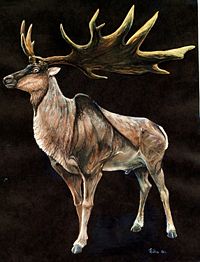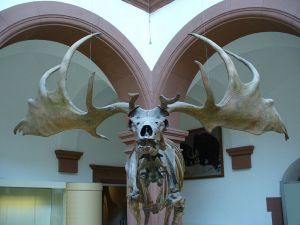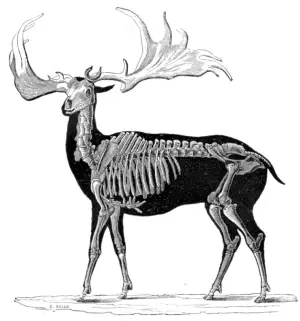Difference between revisions of "Irish Elk" - New World Encyclopedia
Rick Swarts (talk | contribs) (added article from Wikipedia and credit/category tags) |
Rick Swarts (talk | contribs) |
||
| Line 39: | Line 39: | ||
==References==<!-- ZOOLOGICAL SCIENCE 22: 1031–1044 (2005) —> | ==References==<!-- ZOOLOGICAL SCIENCE 22: 1031–1044 (2005) —> | ||
<references/> | <references/> | ||
| + | |||
| + | Gould, S. J. 1977. The misnamed, mistreated, and misunderstood Irish elk. Pages 79-90 in S. J. Gould, ''Ever Since Darwin: Reflections in Natural History''. New York: W. W. Norton. | ||
==Further reading== | ==Further reading== | ||
Revision as of 00:49, 18 February 2009
| Irish Elk
| ||||||||||||||
|---|---|---|---|---|---|---|---|---|---|---|---|---|---|---|
 | ||||||||||||||
| Scientific classification | ||||||||||||||
| ||||||||||||||
| †Megaloceros giganteus (Blumenbach, 1799) | ||||||||||||||
|
†Megaceros giganteus |
The Irish Elk or Giant Deer, Megaloceros giganteus[1][2] was a species of Megaloceros and one of the largest deer that ever lived. Its range extended across Eurasia, from Ireland to east of Lake Baikal, during the Late Pleistocene. The latest known remains of the species have been carbon dated to the early Holocene about 11,000 years ago.[3] Its common name the Irish Elk is misleading. Although large numbers of skeleton have been found in Irish bogs, the animal was not exclusively Irish, and neither was it closely related to either of the living species currently called elk; for this reason, the name "Giant Deer" is preferred in more recent publications. Megaloceros giganteus appeared for the first about 400,000 years ago. It possibly evolved from M. antecedens. The earlier taxon — sometimes considered a paleosubspecies M. giganteus antecedens — is similar but had more compact antlers.
The Irish Elk stood about 2.1 meters (6.9 ft) tall at the shoulders, and it had the largest antlers of any known cervid (a maximum of 3.65 m (12.0 ft) from tip to tip and weighing up to 40 kilograms (88 lb)). In body size, the Irish Elk matched the extant Moose subspecies of Alaska as the largest known deer.[4] A significant collection of M. giganteus skeletons can be found at the Natural History Museum in Dublin.
Evolution of Antler Size
The size of Irish Elk antlers is distinctive, and several theories have arisen as to their evolution. One theory was that their antlers, under constant and strong sexual selection, increased in size because males were using them in combat for access to females; it was also suggested that they eventually became so unwieldy that the Irish Elk could not carry on the normal business of life and so became extinct. However, it was not until Stephen Jay Gould's important 1974 essay on Megaloceros that this theory was tested rigorously.
Gould demonstrated that for deer in general, species with larger body size have antlers that are more than proportionately larger, a consequence of allometry, or differential growth rate of body size and antler size during development. In fact, Irish Elk had antlers of just the size one would predict from their body size. Note this does not mean that sexual selection played no part in maintaining large antler size, only that the antlers of the species' ancestors were already large to begin with. Indeed, Gould concluded that the large antler size and their position on the skull was very much maintained by sexual selection: They were morphologically ill-suited for combat between males, but their position was ideal to present them to intimidate rivals or impress females. Unlike other deer, M. giganteus did not even have to turn its head to present the antlers to best effect, but could accomplish this by simply looking straight ahead.[5]
Extinction
Discussion of the cause of their extinction has focused on the antlers (rather than on their overall body size), which may be due more to their impact on the observer than any actual property. Some have suggested hunting by man was a contributing factor in the demise of the Irish Elk as it was with many prehistoric megafauna, even assuming that the large antler size restricted the movement of males through forested regions or that it was by some other means a "maladaptation" (see Gould 1974). But evidence for overhunting is equivocal, and as a continental species, it would have co-evolved with humans throughout its existence and presumably have adapted to their presence.
More recent research pointed out that high amounts of calcium and phosphate compounds are required to form antlers, and therefore large quantities of these minerals are required for the massive structures of the Irish Elk. The males (and male deer in general) met this requirement partly from their bones, replenishing them from foodplants after the antlers were grown or reclaiming the nutrients from discarded antlers (as has been observed in extant deer). Thus, in the antler growth phase, male deer from Ireland were suffering from a condition similar to osteoporosis.[6]
When the climate changed at the end of the last Ice Age, the vegetation in the animal's habitat also changed towards species that presumably could not deliver sufficient amounts of the required minerals, at least in the western part of its range. The most recent specimen of M. giganteus in northern Siberia, dated to 7,700 years ago - well after the end of the last Ice Age -, shows no sign of nutrient stress. This is actually quite unsurprising, as they come from a region with continental climate where the proposed vegetation changes had not (yet) occurred.[7]
In conclusion, it is easy to advance a number of hypotheses regarding the disappearance of the more localized populations of this species. The situation is less clear regarding the final demise of the Irish Elk in continental Eurasia east of the Urals however. Stuart et al. (2004) tentatively suggest that a combination of human presence along rivers and slow decrease in habitat quality in upland presented the last Irish Elk with the choice of good habitat but considerable hunting pressure, or general absence of humans in suboptimal habitat.
ReferencesISBN links support NWE through referral fees
- ↑ Geist, Valerius (1998): Megaloceros: The Ice Age Giant and Its Living Relatives. In: Deer of the World. Stackpole Books. ISBN 0-8117-0496-3
- ↑ Lister, A.M. (1987): Megaceros or Megaloceros? The nomenclature of the giant deer. Quaternary Newsletter 52: 14-16.
- ↑ Stuart, A.J.; Kosintsev, P.A.; Higham, T.F.G. & Lister, A.M. (2004): Pleistocene to Holocene extinction dynamics in giant deer and woolly mammoth. Nature 431(7009): 684-689. PMID 15470427 Digital object identifier (DOI): 10.1038/nature02890 PDF fulltext Supplementary information. Erratum in Nature 434(7031): 413, Digital object identifier (DOI): 10.1038/nature03413
- ↑ http://www.motherearthnews.com/Nature-Community/1989-03-01/Of-Moose-Megaloceros-and-Miracles.aspx
- ↑ Gould, Stephen J. (1974): Origin and Function of 'Bizarre' Structures - Antler Size and Skull Size in 'Irish Elk', Megaloceros giganteus. Evolution 28(2): 191-220. Digital object identifier (DOI): 10.2307/2407322 (First page text)
- ↑ Moen, R.A.; Pastor, J. & Cohen, Y. (1999): Antler growth and extinction of Irish Elk. Evolutionary Ecology Research 1: 235–249. HTML abstract
- ↑ Hughes, Sandrine; Hayden, Thomas J.; Douady, Christophe J.; Tougard, Christelle; Germonpré, Mietje; Stuart, Anthony; Lbova, Lyudmila; Carden, Ruth F.; Hänni, Catherine; Say, Ludovic (2006): Molecular phylogeny of the extinct giant deer, Megaloceros giganteus. Molecular Phylogenetics and Evolution 40(1): 285–291. Digital object identifier (DOI): 10.1016/j.ympev.2006.02.004 PDF fulltext. Supplementary data 1, DOC fulltext Supplementary data 2, DOC fulltext Supplementary data 3, DOC fulltext
Gould, S. J. 1977. The misnamed, mistreated, and misunderstood Irish elk. Pages 79-90 in S. J. Gould, Ever Since Darwin: Reflections in Natural History. New York: W. W. Norton.
Further reading
- Kurten, Bjorn (1995): Dance of the Tiger. University of California Press. ISBN 0-520-20277-5.
- Kurten is a paleo-anthropologist, and in this novel he presents a theory of Neanderthal extinction. Irish elk feature prominently, under the name shelk which Kurten coins to avoid the problematic aspects of "Irish" and "elk" as discussed above. The book was first published in 1980, when the name "Giant Deer" was not yet being used widely.
External links
- "Extinct Giant Deer Survived Ice Age, Study Says". N.Geographic.
- CGI picture from "Walking with Beasts". Discovery Channel. Retrieved February 14 2006.
- Megaloceros, Irish elk, Giant deer. BBC. Retrieved October 25 2005.
- The Case of the Irish Elk. University of California at Berkeley. Retrieved October 25 2005.
Credits
New World Encyclopedia writers and editors rewrote and completed the Wikipedia article in accordance with New World Encyclopedia standards. This article abides by terms of the Creative Commons CC-by-sa 3.0 License (CC-by-sa), which may be used and disseminated with proper attribution. Credit is due under the terms of this license that can reference both the New World Encyclopedia contributors and the selfless volunteer contributors of the Wikimedia Foundation. To cite this article click here for a list of acceptable citing formats.The history of earlier contributions by wikipedians is accessible to researchers here:
The history of this article since it was imported to New World Encyclopedia:
Note: Some restrictions may apply to use of individual images which are separately licensed.



